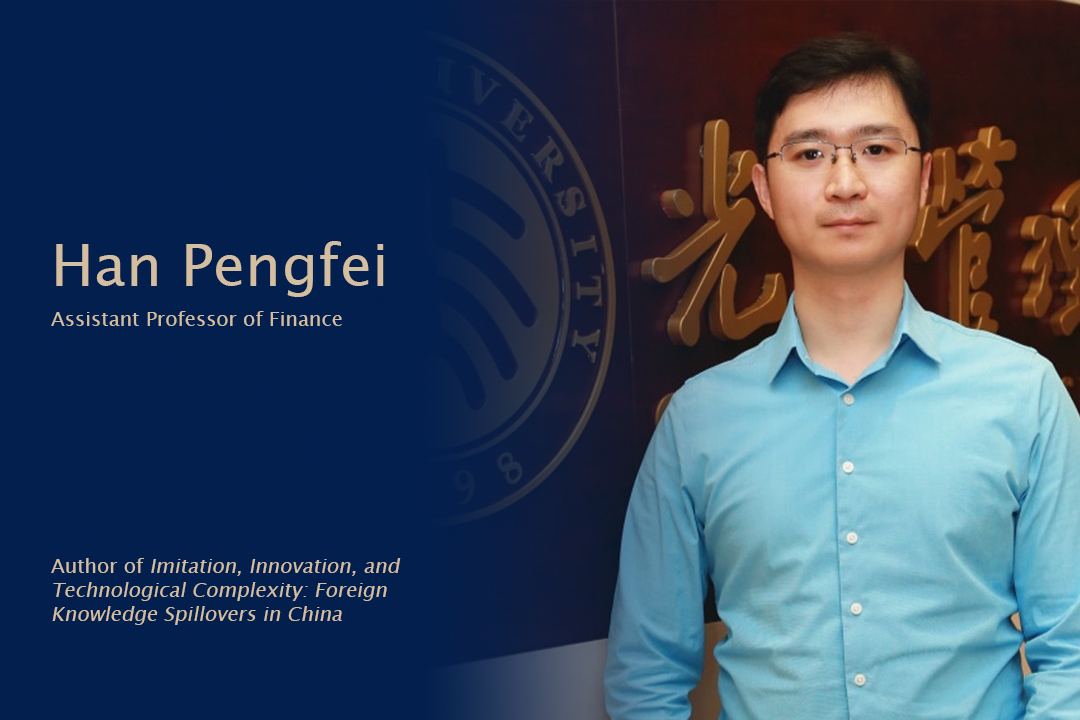
Professor Han Pengfei collaborated with his peers to examine the phenomenon of foreign knowledge spillovers in China. In this study, the team found that over time, Chinese firms have gained leadership over foreign firms in China both in terms of production and patenting. However, while foreign firms have lost market leadership in low-tech (simple) industries, they have maintained strong leadership in high-tech (complex) industries. Exploring foreign knowledge spillovers using patent citations data, the team also shows that only firms in low-tech (simple) industries eventually decrease their reliance on foreign knowledge for innovation. The findings suggest that imitation is a path to indigenous innovation only in low-tech (simple) industries and point to the need of industry-specific policies.
Introduction
In the last three decades, China has been transforming itself from a“world factory” to a global innovation powerhouse. At the same time, multinational firms entering China have fuelled widespread concerns in developed countries about the risks of imitation due to easier knowledge spillovers and technological transfers. These concerns have not eased with time, as evidenced by the increase in protectionism and international litigations. However, the extent to which foreign knowledge spillovers have contributed to the rise of China’s innovation is still not clear. On one hand, firms like Alibaba and Huawei have been able to rise to the technological frontier learning from foreign business models and technologies and dominating their markets. On the other hand, domestic firms in the semiconductor and pharmaceutical industries in China, for instance, continue to lag behind the foreign lead despite the intense presence of multinationals on Chinese soil. How did foreign knowledge spillovers contribute to the drastic transition of the Chinese economy in the last decade? Are the returns of foreign knowledge spillovers the same across industries? Does imitation provide a uniform path to the technological frontier?
Data
To study the role of foreign knowledge spillovers in China, the team assembled a novel firm and patent-level data set that combines firm accounting information with patenting and cross-citation information of Chinese enterprises. In particular, data from Annual Survey of Industrial Enterprises (ASIE) with the patent data from the Chinese National Intellectual Property Administration (CNIPA) were combined. The findings are summarized as follows.
Trends in the transition of Chinese firms in technology frontier
Following China’s accession to the World Trade Organization (WTO), foreign firms flocked to the Chinese market and started innovating and patenting in China. As a result, they rapidly gained market shares in the early 2000s, dominating numerous industries in China in patenting and sales. However, over time, Chinese firms increased their aggregate output and patent shares with respect to foreign firms. As a consequence, the entry of new foreign firms and the importance of foreign incumbents in China have declined. Hence, the production and innovation shares of foreign firms in China exhibit a salient hump-shaped pattern in the last two decades.
The role of foreign knowledge spillovers
The aggregate dynamics, however, mask significant cross-industry heterogeneity. Foreign output share and patent share experienced drastically distinct trends in industries with different R&D intensity and technological complexity. In high-tech (complex) industries, foreign output and patent shares surged after China joined WTO, and both shares remained flat after reaching their peak. Foreign companies have not lost their industry leadership in high-tech (complex) sectors. In contrast, foreign firms experienced a sharp decline in both the output and patent shares in low-tech (simple) industries. These findings suggest that the imitation of foreign technology can provide a path to technological development, but primarily in low-tech (simple) industries.
Transformation from imitation to innovation: the case of Huawei
This transformation from imitation to innovation is epitomized by Huawei Technologies Co. Ltd., a leading Chinese producer of telecommunications equipment and smartphones. In the early 2000s, Huawei relied heavily on imitating the products of global telecommunications equipment producers.Over time, however, Huawei gradually increased its R&D spending to develop its own technology.Huawei spent RMB 101.5 billion (14.1% of sales) on R&D in 2018, ranking fifth globally in the 2018 EU Industrial R&D Investment Scoreboard. In addition, Huawei also customized its products to cater to the local demand of Chinese users. For instance, to crack the market of small towns in rural China, Huawei developed customized technologies to adapt to a myriad of adverse local conditions, ranging from poor transmission quality to rats chewing the electrical wires. Thanks to its enormous R&D spending and customer experience-based innovation, Huawei has overtaken Ericsson and become the largest telecommunications equipment company in the world. It has also surpassed Apple and has become the world’s second-largest smartphone maker, only second to Samsung. As a result, many Chinese companies increasingly turned to Huawei instead of Cisco and Ericsson to learn about the frontier innovative technologies.
Thus, this study supports the idea that firms in emerging markets can learn from foreign innovation in their country. In fact, China has shown that the student can even surpass the teacher in many industries. Though Alibaba relied heavily on imitating the U.S. e-commerce giants in its infancy, it has more sales than Amazon and eBay combined now. Nevertheless, imitation is not a warranty of success. Results from this study show that in complex industries, foreign firms have a natural protection from local competitors and they are better positioned to reap the benefits of cheap labour and large destination market size. This duality has potentially interesting policy implications. For instance, from a developing market perspective, the entry of low-tech foreign firms is highly desirable; while from a developed economy perspective, high-tech multinationals should be the ones with the highest incentives to relocate to emerging markets.
Contributions to the literature
This paper contributes to the growing body of literature on innovation in China, especially the studies based on patent data. This paper also complements studies on knowledge spillovers by using patent citations patterns to measure foreign knowledge spillovers in China. Lastly, an important new insight from this analysis pertains to the heterogeneous role of knowledge spillovers across industries with different technological complexities. The importance of industry-specific technological complexity provides supporting evidence for models where innovation and imitation co-exist.
Conclusion
Overall, this study provides new insights for policy discussions. Because complex industries have a natural protection from spillovers in developing countries, we should expect lower incentives for protectionism by developed countries on complex industries, when compared to simpler ones. However, from a developing market perspective, low-complexity industries offer the highest spillovers and should face lower entry barriers. Moreover, the results also indicate that weak patent laws in developing countries might be useful for domestic learning of low-complexity innovations. However, conquering high-complexity industries might require long-term investments that are often discouraged by weak patent laws.
Future work should focus on the factors that underlay the natural limits to imitation faced by developing countries. For instance, can education and skill acquisition allow Chinese firms to learn from more complex foreign technologies? Perhaps trade, education, and patent right policies should be designed jointly and acknowledge salient industry heterogeneity documented in this paper.

About the Author
Dr. Han Pengfei is an assistant professor of finance at Guanghua School of Management, Peking University. He received his Ph.D. degree in economics from the University of Pennsylvania in 2018. His research focuses on innovation, entrepreneurship, venture capital, firm dynamics, and economic growth. His recent work includes studies on US-China technology decoupling, cross-country comparison of mobile payment, entrepreneurial finance under the COVID-19 pandemic, and the market for technology in China.
 Programs
Programs